| Chequered Skipper
(more images)
|
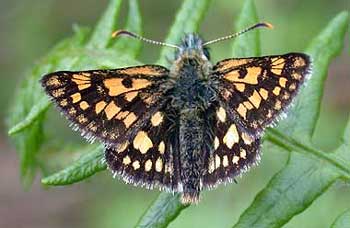 |
Only skipper with chequered upperwing pattern.
|
Sunny scrubby areas along the edges of copses.
|
Restricted to Inverness and Argyll in Western Scotland. |
Rare
|
Duke of Burgundy
|
| Dingy Skipper
(more images)
|
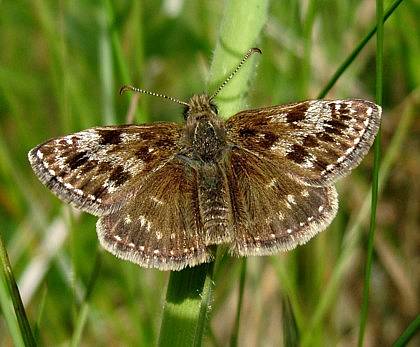 |
Grey-brown upperwings with tiny white dots along the wing edges, fringed pale grey. |
Coastal dunes and rough ground, chalk and limestone downland. |
Widely distributed - the only skipper species in Ireland. |
Local |
Grizzled Skipper |
| Grizzled Skipper
(more images)
|
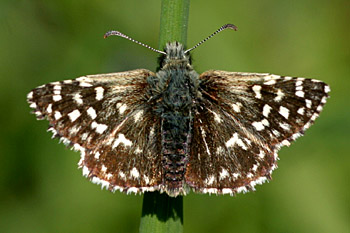 |
Checkerboard upperwings with black and white barring to fringes. |
Clearings, woodland rides and edges, grassland with scrub. |
Declining in central southern counties, scarce in south-west and midlands. Absent from Scotland and Ireland. Very rare in Wales. |
Scarce |
Dingy Skipper |
| Lulworth Skipper
(more images)
|
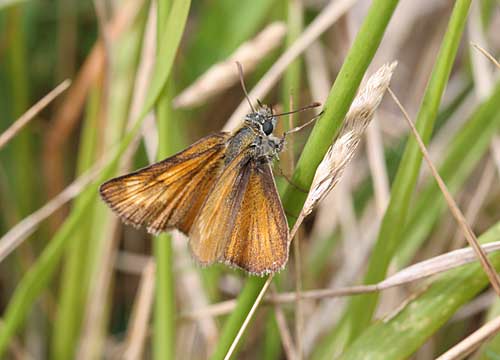 |
Smallest and darkest skipper. Brown upperwing with dusting of gold in the shape of a peacock's feather in the female. |
South-facing hillsides, cliff tops and undercliffs. |
All British colonies restricted to Dorset. |
Rapidly declining in Europe, although colonies in Dorset doing well. |
Large Skipper, Silver-spotted Skipper |
| Essex Skipper
(more images)
|
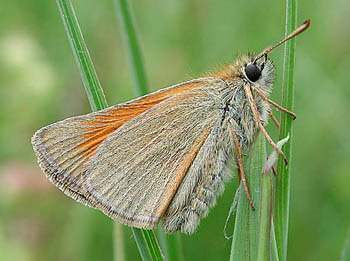 |
Bright orange-brown upperwings. |
Rough, tall grassland, hedgerows, road verges, woodland edge, wetlands and salt marsh. |
Confined to England south of the Humber. Scattered colonies along coastal areas in south-west counties. |
Common |
Small Skipper |
| Small Skipper
(more images)
|
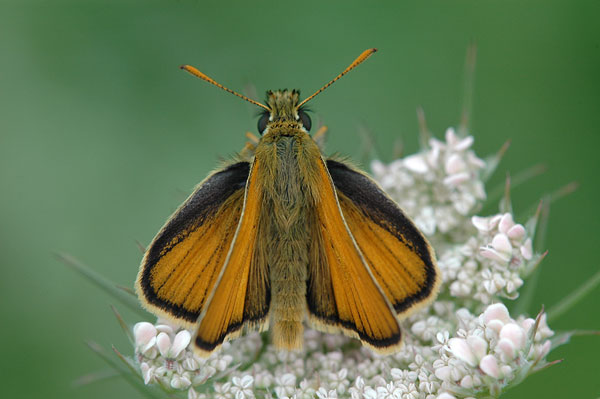 |
Bright orange-brown upperwings. |
Rough grassland, wasteland and along woodland rides and edges. |
England and Wales, but absent from north-west England, Scotland and Ireland. |
Common |
Essex Skipper (almost indistinguishable), Lulworth Skipper |
| Silver-spotted Skipper
(more images)
|
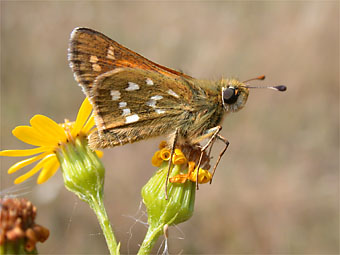 |
Olive-green underwings with silver patches. |
Southern chalk downs. |
Chilterns, North Dorset, Hampshire, Sussex and Kent. One isolated site in Somerset. |
Rare |
Large Skipper |
| Large Skipper
(more images)
|
 |
Brown-edged upperwings with bright orange patches divided by black veins. |
Prefers more sheltered sites in unimproved grassland, hedgerows and road verges, woodland glades and edges. |
Lowland areas of England and Wales. Northward expansion into Scotland, but remains scarce. |
Common |
Silver-spotted Skipper, Lulworth Skipper |
| Swallowtail
(more images)
|
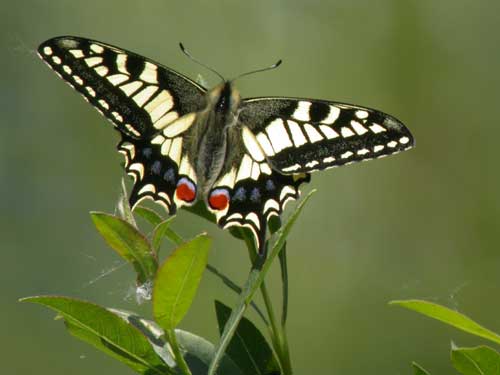 |
Unmistakeable bold back and pale yellow wing markings and long tails below a blue border and orange eye. |
Wetlands and fens. |
Confined to the Norfolk Broads. Occasional migrants along the south coast. |
Rare |
|
| Wood White
(more images)
|
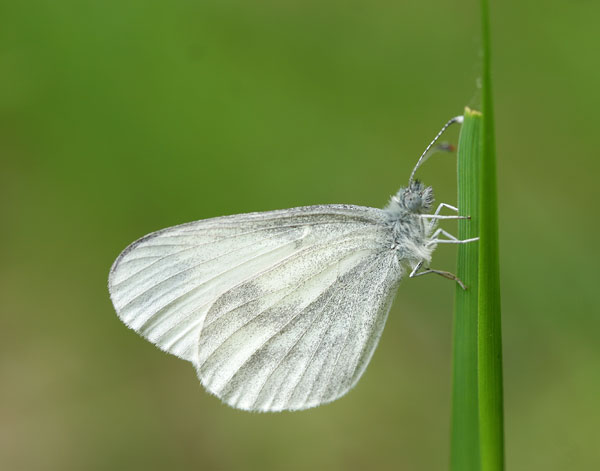 |
Smallest of the "whites". Rests with wings closed – long, thin oval shape characteristic – dainty fluttering flight distinctive. |
Cleared woods, ditches and rides in young plantations, abandoned railway cuttings. |
Southern English Midlands, Wye Valley, East Wales and home counties including the Weald. Absent from Ireland except Galway. |
Scarce |
Green-veined White; Real's Wood White (Ireland) |
| Real's Wood White
(more images)
|
 |
Indistiguishable from Wood White. Best seperated therefore based on non-overlapping distribution. |
Grassland, meadows, fen and bog. |
Ireland, but not present in County Galway where Wood White is present. |
Local |
Wood White |
| Clouded Yellow
(more images)
|
 |
Deep yellow underwings with black spot midway across forewing. Pair of silver spots with chestnut border on hind-wing. In flight rich orange upperwings with black borders. |
Southern downland and coastal grassland. |
Migrant from southern Europe reaching British shores in variable numbers each spring. |
Common in irruption years. |
|
| Brimstone
(more images)
|
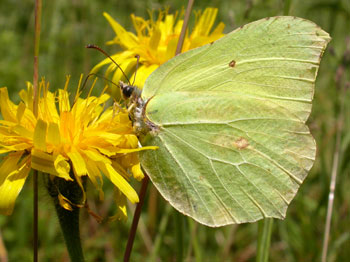 |
Large butterfly with pale yellow wings (paler in female) with pointed corners and prominent veins and a "mould" spot in the centre. |
Woods, hedgerows and gardens. |
Southern England up to Humberside. Localised in Wales. |
Common |
Clouded Yellow, Large White |
| Large White
(more images)
|
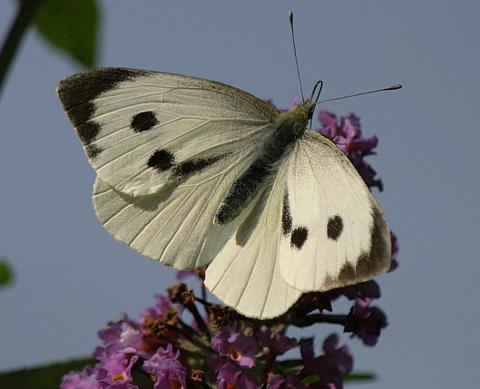 |
Large butterfly with clean white wings with conspicuous black tips to the forewings. |
Vegetable gardens, allotments and cabbage fields. |
Throughout British Isles. |
Common – with swarming in some years with migrants from the continent. |
Small White |
| Small White
(more images)
|
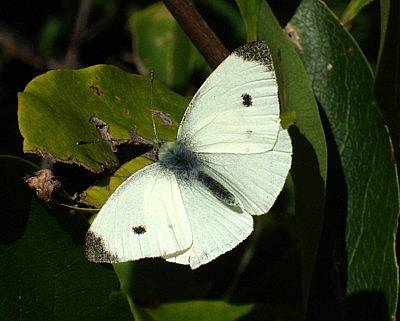 |
Smaller of the two "cabbage" whites – upperwings are clear white. |
Vegetable gardens, allotments and cabbage fields. |
Throughout British Isles although localised in Northern Scotland. |
Common |
|
| Green-veined White
(more images)
|
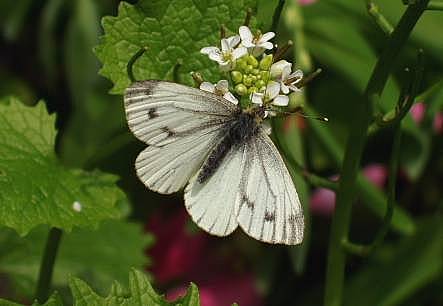 |
Broad grey-green veins on underwings. |
Found in all habitats but most often found around breeding sites in damp, boggy meadows, riversides and ditches. |
Throughout British Isles although absent from Shetland and parts of the Scottish Highlands. |
Common |
Small White |
| Orange Tip
(more images)
|
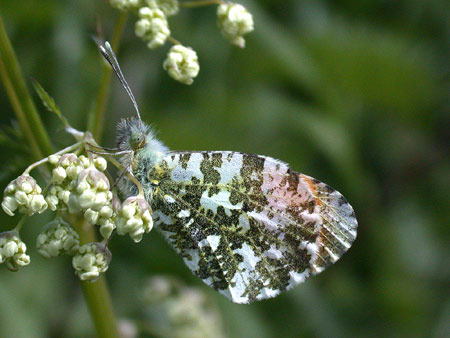 |
Bright orange wing tips of male distinctive. Mottled moss-green undersides of hindwing distinctive in both sexes. |
Wide range of habitats including tall open grassland and woodland rides. |
Common throughout England, Ireland and Wales, localised in parts of Scotland. Absent from the Highlands and Islands and the far north. |
Common |
Small White, Green-veined White (females only) |
| Green Hairstreak
(more images)
|
 |
Unmistakeable bright green undersides to wings. Plain brown uppersides. |
Wide range of habitats including moorland, lowland heath, downland, woods and rough scrub. |
The most widely distributed hairstreak, but recent reclamation of old grassland habitat and intensive forestry has reduced its distribution. |
Local |
Dingy Skipper or female "Blue" in flight. |
| Brown Hairstreak
(more images)
|
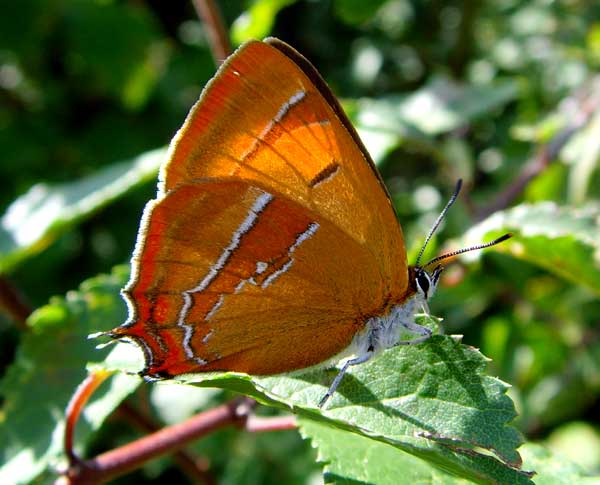 |
Golden underwings intersected by two white lines. Brown upper-wings with large orange patches in the female. |
Woodland or hedged fields with Ash or Blackthorn. |
Largest populations in the Weald of Surrey and Sussex, Devon and south-west Wales. Smaller colonies elsewhere in Southern English counties and Lincolnshire. |
Scarce |
Gatekeeper |
| Purple Hairstreak
(more images)
|
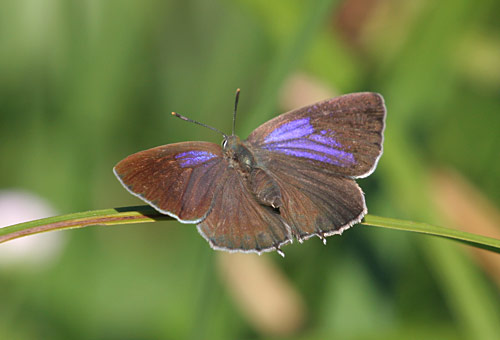 |
Black upperwings turning purple in the sun. Silver-grey under-wings with white streak and orange eye. |
Oak woodland. |
Common in woodlands south of the Wash, localised further north. |
Common |
White-letter Hairstreak |
| White-letter Hairstreak
(more images)
|
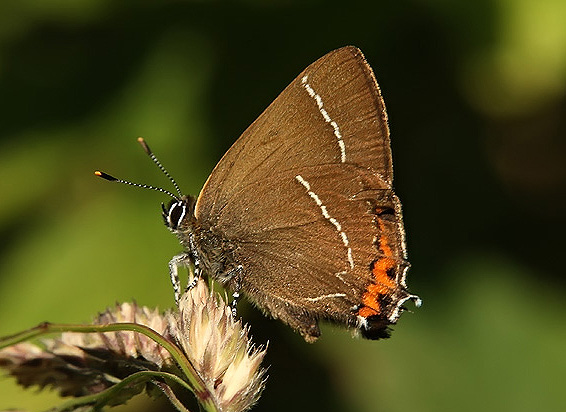 |
Underwings are blackish-brown with thin W-shaped white line and orange crescents along edge of hind-wing. |
Elm trees especially Wych Elm. |
Throughout Wales and England as far north as Yorkshire. Abundant in the English Midlands. |
Local |
Black Hairstreak |
| Black Hairstreak
(more images)
|
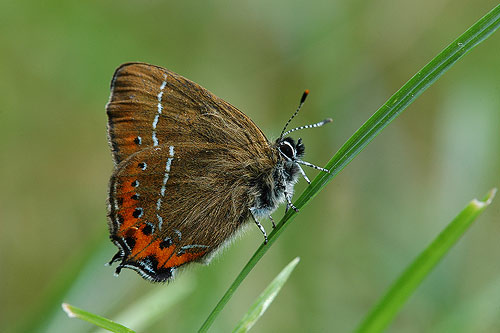 |
Golden-brown underwings with white streak and diagnostic orange border with row of black spots. |
Woodland or hedgerow with Blackthorn. |
About 30 colonies exist in the East Midlands. |
Rare |
White-letter Hairstreak |
| Small Copper
(more images)
|
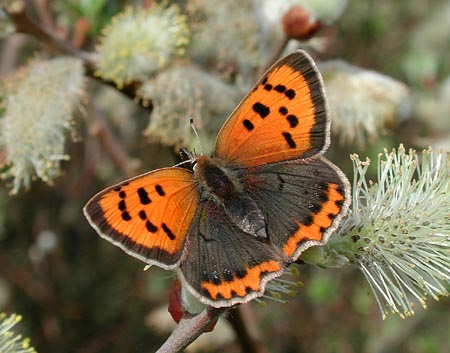 |
Bright copper upper forewings with black marks. Copper border along hindwing. |
Rough open spaces including grassland, heath, sunny woodland rides and occasionally gardens. |
Throughout British Isles, absent only from higher mountainous parts of Scotland and the Scottish Isles. |
Common but declining |
|
| Small Blue
(more images)
|
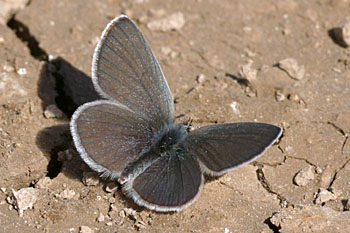 |
Tiny butterfly – male has silvery blue upper-wings (female brown) with no markings. Silver-grey underwings with row of black spots. |
Colonial butterfly found in chalk pits, embankments and downland. |
Widespread distribution with main strongholds in the Cotswolds, Wiltshire, Dorset and the Isle of Wight. |
Extremely rare |
Holly Blue, Brown Argus in flight |
| Silver-studded Blue
(more images)
|
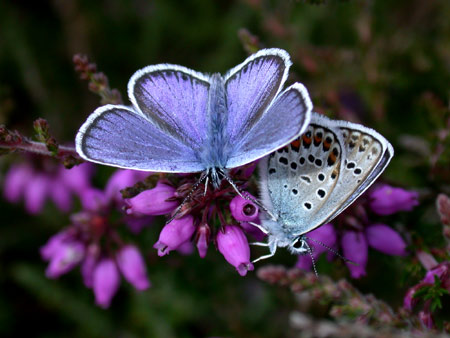 |
White fringes and broad black border to blue upperwings. Distinctive underwing pattern with orange and black peacock-like studs. |
Heathland and dunes. |
Largest populations found in Sussex, Surrey, Hampshire and Dorset, but also locally in Norfolk, Suffolk and North Wales. |
Rare |
Brown Argus species |
| Brown Argus
(more images)
|
 |
Sooty brown upperwings with crescent of orange spots along edge. |
Chalk and limestone grassland, dunes, woods and cliffs. |
South-east England and coast of Wales. Locally at coastal sites in the west country. |
Local |
Northern Brown Argus |
| Northern Brown Argus
(more images)
|
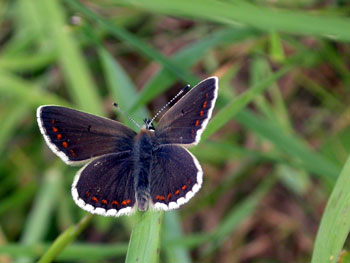 |
Almost identical to Brown Argus but with white spot in centre of forewing in northern colonies. |
Mountains with broken scree and rough grassland. |
Scotland and Northern England. |
Local |
Brown Argus |
| Common Blue
(more images)
|
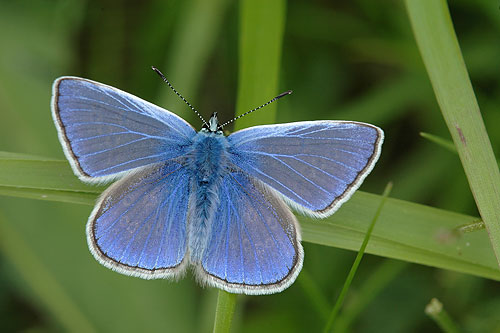 |
Males have bright blue unmarked upperwings. Female upper wing colour varies from purple through brown with orange crescents along outer edge. |
Dunes, cliffs, heathland and rough short-cropped grassland. |
Found throughout British Isles absent only above 500m and the far north Shetland Isles. |
Common |
Holly, Adonis and Silver-studded Blue |
| Chalkhill Blue
(more images)
|
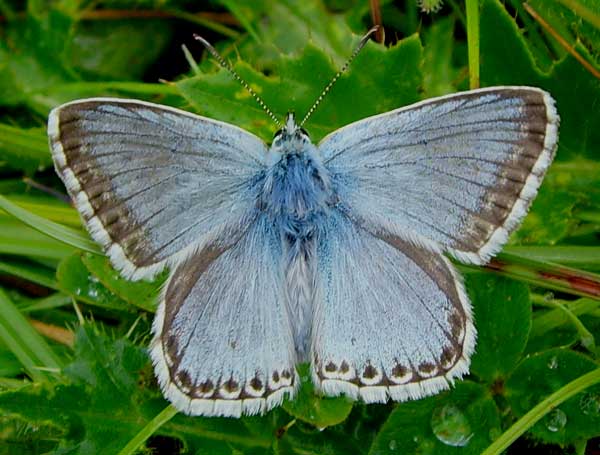 |
Large "blue" with pale, slivery-grey upperwings in the male. Female has brown upperwings. |
Chalk and limestone downland. |
North and South Downs and other similar habitat in Surrey, Kent, Sussex, Hampshire and the Isle of Wight, Wiltshire and Dorset. |
Local
|
Adonis Blue (females only) |
| Adonis Blue
(more images)
|
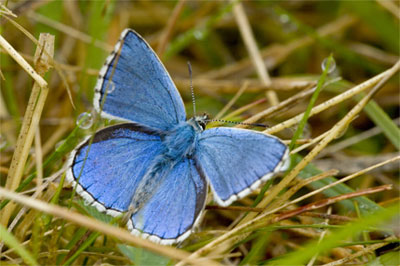 |
Brilliant turquoise-blue upperwings edged with thin black line. Female has brown upperwings, near identical to Chalkhill Blue. |
South-facing chalk or limestone grassland. |
North and South Downs and other similar habitat in Surrey, Kent, Sussex, Hampshire and the Isle of Wight, Wiltshire and Dorset. |
Scarce |
Chalkhill Blue (females only) |
| Holly Blue
(more images)
|
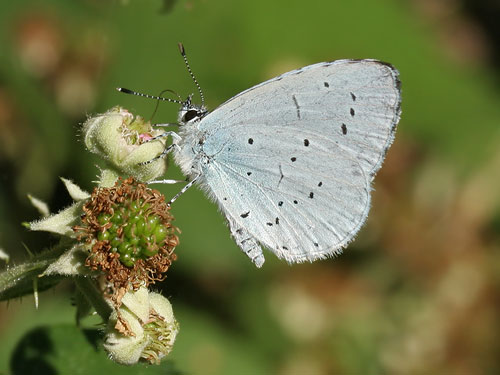 |
Diagnostic underwing lacking orange marks but tiny black dots. Upperwings violet blue. |
Gardens, hedgerows and woods. |
Throughout England although commonest in the South. Local in Ireland and Wales. |
Common |
Small Blue |
| Large Blue
(more images)
|
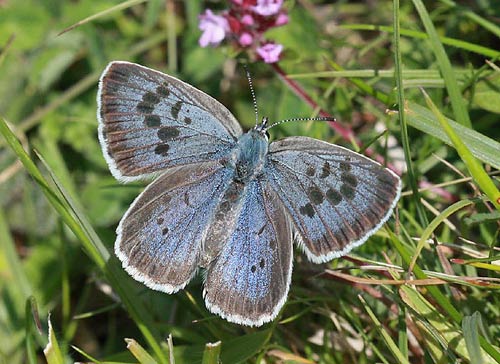 |
Broad black borders to blue upperwings with 4-6 black spots. Black spots but no orange marks on underwing. |
Colonial species found on grazed, unfertilised south-facing grassland. |
Sites on Dartmoor, in Cornwall and the Cotswolds. |
Extremely Rare |
Female Holly Blue, male Common Blue |
| Duke of Burgundy
(more images)
|
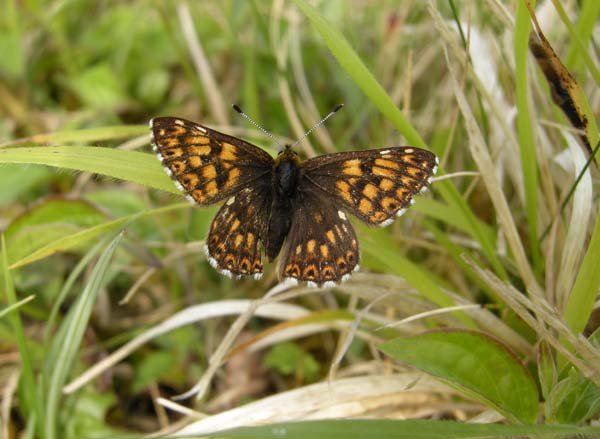 |
Size and shape of a "Blue" but with the markings of a Fritillary. Upper and underwing black with orange patches and black spots. |
Chalk and limestone grassland and recently cleared woodland. |
Strongholds in Wiltshire and Hampshire, but smaller colonies elsewhere including North Yorkshire and the Lakes. |
Rapidly declining |
Small Copper |
| White Admiral
(more images)
|
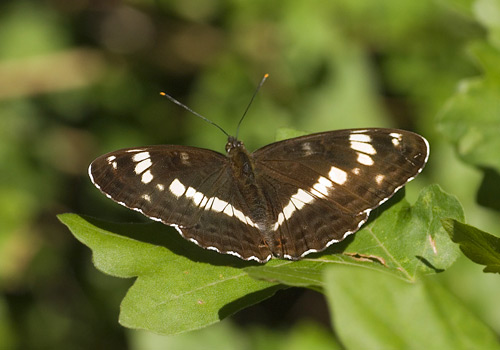 |
Dusky brown upperwings with wide white band. Pattern repeated on underwing. |
Shady woodlands. |
England south of the Humber, especially Southern Central counties. |
Local |
|
| Painted Lady
(more images)
|
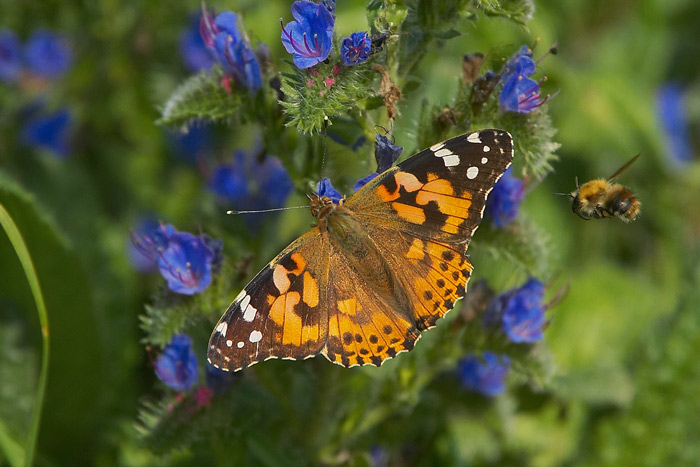 |
Chequered upperwing pattern of black veins and black and white patches on dull orange wings. Hind underwing has intricate pattern with dark eye-spots. |
Any sunny habitat including gardens. |
Throughout British Isles. |
Common (in some years) migrant. |
|
| Purple Emperor
(more images)
|
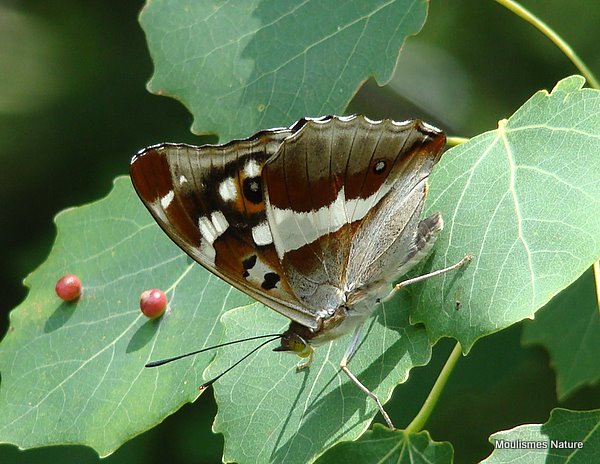 |
Large butterfly with dusky purple upperwings with white band across hindwings and white spots on forewings. |
Large forests and woodlands. |
Central Southern English counties especially Surrey and Sussex. |
Scarce |
White Admiral |
| Small Tortoiseshell
(more images)
|
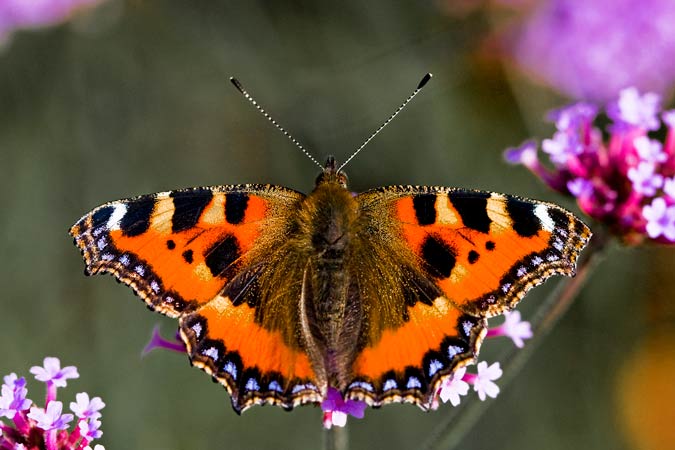 |
Bright orange upperwings with dark border of blue crescents and six black patches on each forewing. |
Sunny, open countryside. |
Throughout British Isles including far north islands. |
Common |
|
| Large Tortoiseshell
(more images)
|
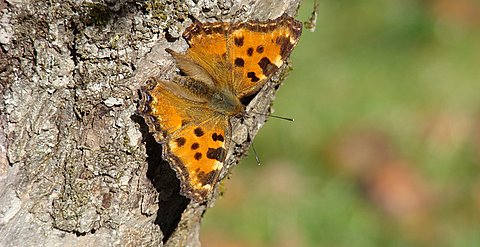 |
Like larger, duller Small Tortoiseshell. |
Forest edges and wooded lanes with Elm. |
Extinct as a resident species. Most sightings are misidentification or captive released stock. |
Extinct |
Small Tortoiseshell |
| Red Admiral
(more images)
|
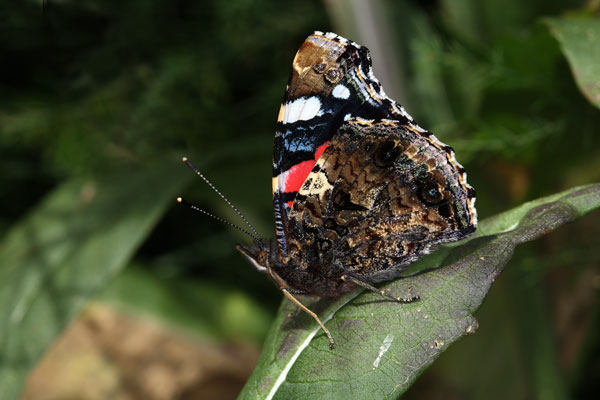 |
Unmistakeable velvet black upperwings with diagonal band of red across each forewing and along edge of hindwing. Conspicuous white patches at top of forewing. |
All habitats especially woods, gardens and hedgerows. |
Throughout British Isles including far north islands. |
Common migrant |
|
| Peacock
(more images)
|
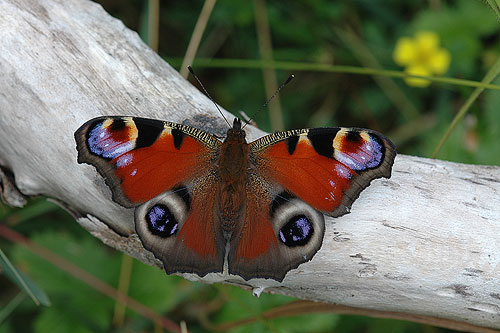 |
Spectacular glossy blue and black peacock eyes on each upperwing against a chestnut- red background. |
Most habitats especially in and around woods. |
England, Wales and Ireland expanding into Southern Scotland. |
Common |
|
| Comma
(more images)
|
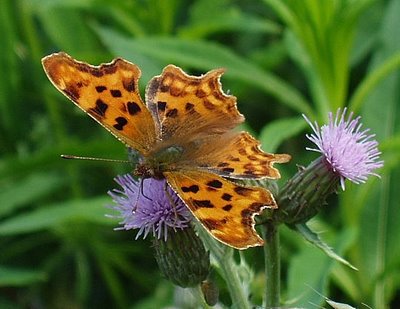 |
Jagged orange upperwings with brown and black blotches. |
Woods, hedges and mature gardens. |
England, Wales and recently South-east Scotland. |
Locally common following rapid recent expansion. |
|
| Small Pearl-bordered Fritillary
(more images)
|
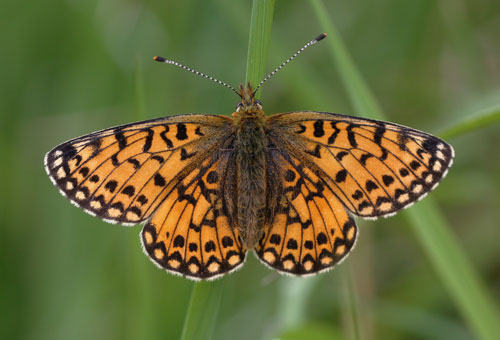 |
Mosaic of yellow underwings with 7 pearls along edge of hindwing. Orange upperwings with black veins, crossbars and spots. |
Moist, grassy habitats, often near woodland edges, also moorland and heath. |
Western areas of Scotland, Wales and England. |
Locally common |
Pearl-bordered Fritillary |
| Pearl-bordered Fritillary
(more images)
|
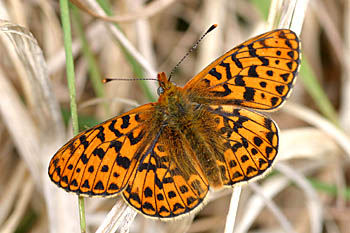 |
Underwing is mosaic of orange and yellow with seven pearls along outer edge of hindwing but only 2 within the wing. Upperwings identical to Small Pearl-bordered Fritillary. |
Scrubby gorse or bracken covered hills. |
Stronghold remains West and Highland areas of Scotland. |
Fast declining species now restricted to a few carefully conserved sites.
|
Small Pearl-bordered Fritillary |
| High-brown Fritillary
(more images)
|
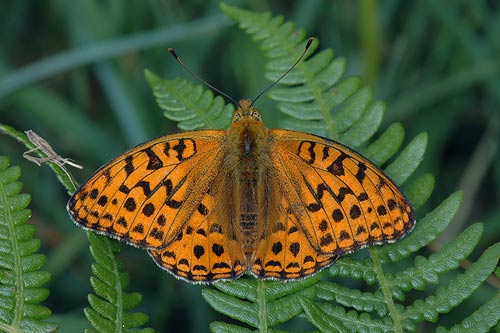 |
Greenish-orange underwings with large silver spots outlined in black. |
Rough grassland and scrubby areas. |
Devon (Dartmoor), Lancashire (Morecombe Bay) and South Wales (Alun Valley) |
Rare |
Dark-green Fritillary |
| Dark-green Fritillary
(more images)
|
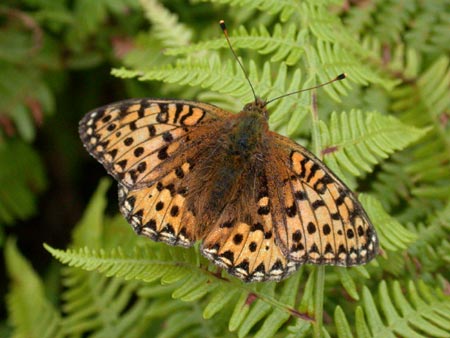 |
Greenish underwings lacking eyes between outer rows of silver spots. |
Cliffs, dunes, moorland and rough grassland. |
Coastline of Britain and hilly areas of Scotland, Wales and SW England. Scarce elsewhere. |
Locally common |
High-brown Fritillary |
| Silver-washed Fritillary
(more images)
|
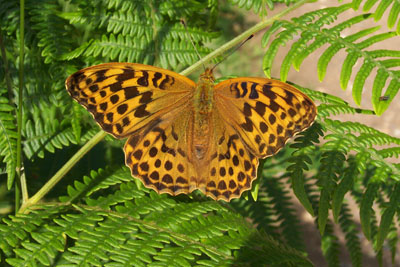 |
Largest and most striking Fritillary with deep orange wings with large black spots and lines. |
Woodland. |
South and South-west England, Wales and Ireland. |
Locally common |
|
| Marsh Fritillary
(more images)
|
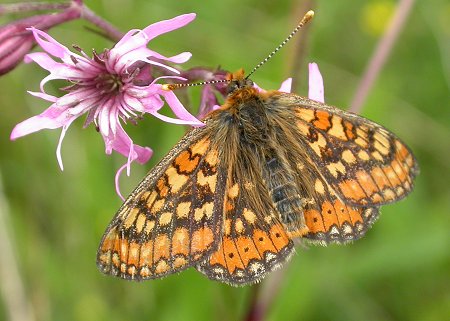 |
Reddish-orange upperwings with strong black veins and crossbars and characteristic row of black dots along edge of hindwing. Generally duller, less distinct Fritillary. |
Open grassland, damp and boggy meadows. |
Grasslands of Cornwall, Devon and Wiltshire, South Wales and Western Scotland. |
Rare |
|
| Glanville Fritillary
(more images)
|
 |
Upper hindwing has row of black spots in orange circles. Under hindwing white with two orange bands outlined in black. |
Cliffs and warm sheltered valleys. |
Isle of Wight. Occasional temporary coloniser to mainland counties. |
Rare |
|
| Heath Fritillary
(more images)
|
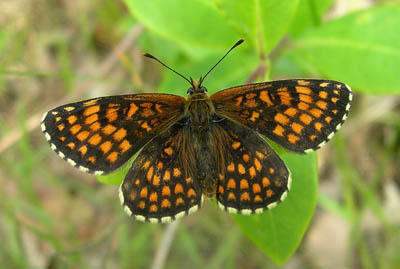 |
Dark Fritillary lacking any spotting on any wing. |
Woodland rides and clearings. |
Kent, Essex and Devon. |
Rare |
|
| Speckled Wood
(more images)
|
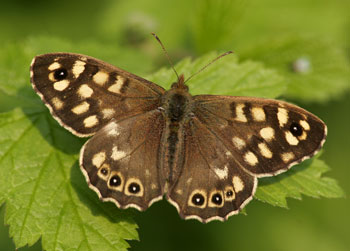 |
Distinctive creamy patches on brown upperwings. Upper hindwing has three black eyes towards rear edge. |
Shaded woodland. |
England (south of Yorkshire), Wales and Ireland. Also northern Scotland. |
Common |
|
| Wall Brown
(more images)
|
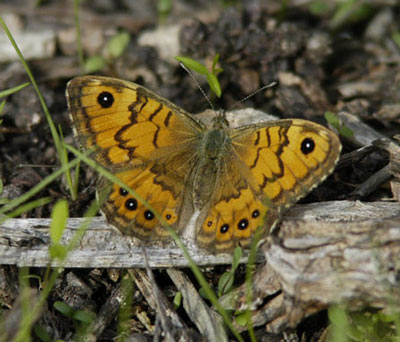 |
Orange upperwings with dark borders and black eye-spot on each forewing. |
Open grassland including wasteland. Cliffs. |
Common neat coastline of England and Wales and Ireland. Scarce in the Midlands and Central Southern England. |
Scarce |
|
| Mountain Ringlet
(more images)
|
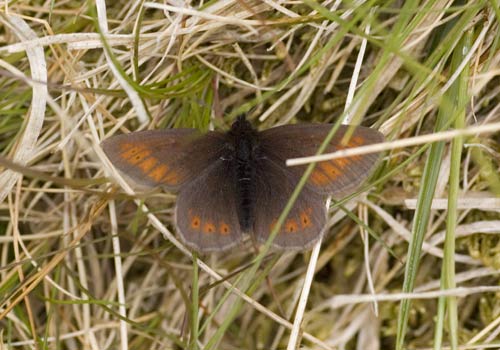 |
Velvet brown upperwings with orange blotches with tiny black dots towards outer edge. |
Grassy areas on mountain sides. |
Lake District and highlands of Scotland. |
Local |
Scotch Argus |
| Scotch Argus
(more images)
|
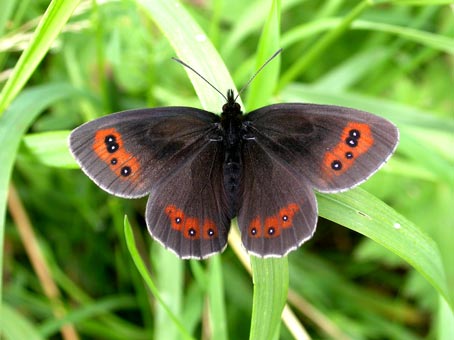 |
Velvet brown upperwings with bold orange blotches and white-pupilled black eye-spots. |
Boggy grassland. |
Lake District and south-west Scotland, the Highlands and inner isles. |
Local |
Mountain Ringlet |
| Marbled White
(more images)
|
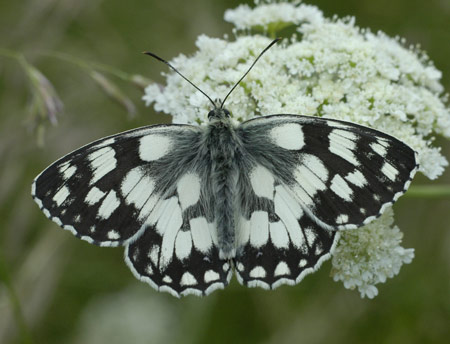 |
Distinctive Black and white chequered upperwings. |
Unfertilised chalk and limestone grassland, cliffs, woodland rides and embankments. |
Central southern and south-west England with colonisation into Yorkshire and the East Midlands. |
Locally common |
|
| Grayling
(more images)
|
 |
Marbled underwings with darker centre separated from paler outer half by ziz-zag boundary. Under forewings have orange centre with two black eye-spots. Upperwings light brown with straw-coloured bands. |
Rough grassland, quarries, cliffs, dunes and lowland heath. |
Coastline of Britain and Ireland. |
Scarce |
|
| Gate Keeper
(more images)
|
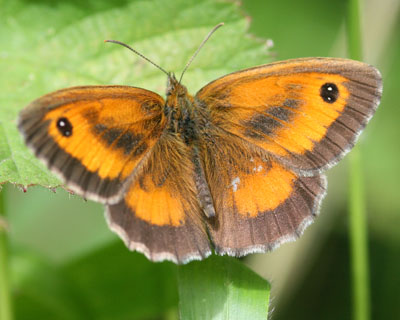 |
Orange patches on both upper wings with single double-pupilled eye-spot on forewing. |
Hedgerows, scrubby grassland and woodland glades. |
Restricted to southern counties north to the Midlands and lowland Wales. Also southern coast of Ireland. |
Common |
Female Meadow Brown |
| Meadow Brown
(more images)
|
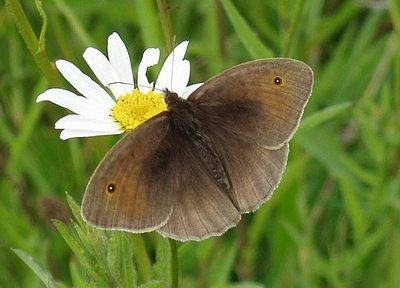 |
Dusky-brown upperwing with one black eye-spot on forewing. Female has obvious orange patch on forewing. |
Any habitat with grasses. |
Throughout British Isles. |
Common |
Small Heath, Large Heath and Ringlet |
| Ringlet
(more images)
|
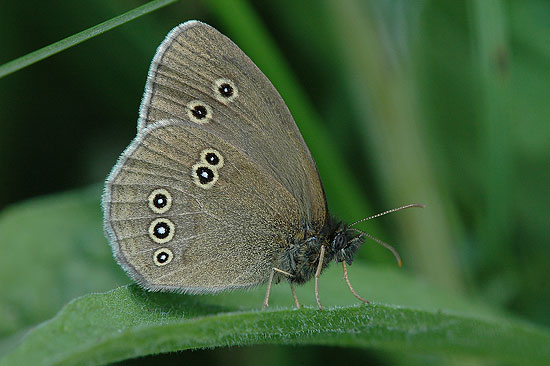 |
Dark brown upperwings with white fringe. Dark underwings with row of characteristic black eyes with white pupils and yellow rings. |
Woodland glades and borders with lush vegetation. Also scrubby rank grassland. |
Wales, Ireland South and eastern England and lowland southern Scotland. |
Local |
Meadow Brown |
| Small Heath
(more images)
|
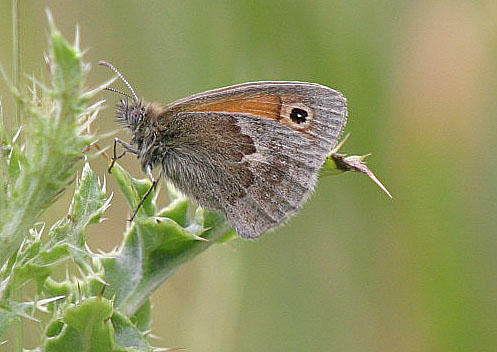 |
Under forewing is orange with black eye-spot. Under hindwing grey-brown with white blotch mid-way out. |
Unimproved grassland, downs, road verges, dunes, heaths and moorland. |
Throughout British Isles. |
Common |
Meadow Brown |
| Large Heath
(more images)
|
 |
Green-grey underwings with pale zig-zag band and string of black eye-spots. More northerly butterflies lack the eye-spots. |
Damp moors and peat bogs. |
Ireland, north Wales and northern England. More widely distributed in Scotland. |
Uncommon |
Meadow Brown |



























































